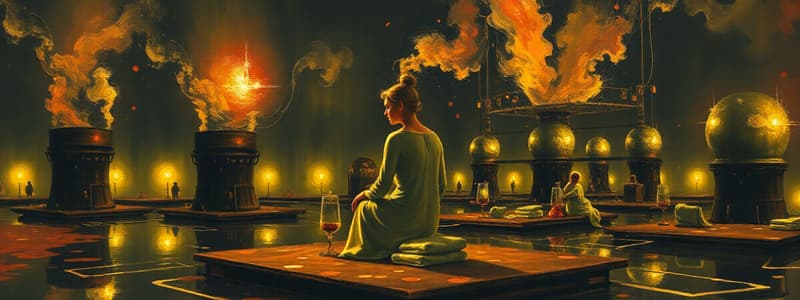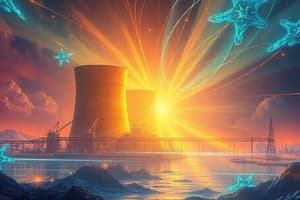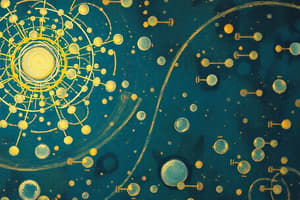Podcast
Questions and Answers
What does neutron flux primarily measure?
What does neutron flux primarily measure?
- The average speed of neutrons in a reactor
- The energy produced per fission reaction
- The total track length traveled by all neutrons in a unit volume per unit time (correct)
- The density of neutrons in a certain volume
What are the units of neutron flux commonly written as?
What are the units of neutron flux commonly written as?
- neutrons/cm2-sec (correct)
- neutrons/cm3-sec
- neutron-s/cm2
- neutron-cm/cm3-sec
In the equation for neutron flux, f = nv, what does 'n' represent?
In the equation for neutron flux, f = nv, what does 'n' represent?
- Number of neutrons in a volume (correct)
- Total energy produced in the reactor
- Fission macroscopic cross-section
- Average track length of neutrons
How would the power of a reactor be calculated using neutron flux?
How would the power of a reactor be calculated using neutron flux?
What does Σf represent in the context of neutron flux and reactor power?
What does Σf represent in the context of neutron flux and reactor power?
What characteristic is necessary for an ideal moderator to effectively slow down neutrons in a nuclear reaction?
What characteristic is necessary for an ideal moderator to effectively slow down neutrons in a nuclear reaction?
How many average collisions are required to thermalize neutrons in H2O compared to D2O?
How many average collisions are required to thermalize neutrons in H2O compared to D2O?
What is the primary consequence of fission reactions in nuclear power plants?
What is the primary consequence of fission reactions in nuclear power plants?
Which material would require the most average number of collisions to achieve thermal neutron energy levels?
Which material would require the most average number of collisions to achieve thermal neutron energy levels?
What is the significance of having a small absorption cross section in a neutron moderator?
What is the significance of having a small absorption cross section in a neutron moderator?
What is the energy released per fission event?
What is the energy released per fission event?
How is power calculated based on fission events?
How is power calculated based on fission events?
What must happen to fast neutrons from fission events to induce more fission reactions?
What must happen to fast neutrons from fission events to induce more fission reactions?
What is the purpose of a moderator in a nuclear reactor?
What is the purpose of a moderator in a nuclear reactor?
Which formula represents the macroscopic total cross-section?
Which formula represents the macroscopic total cross-section?
Which reaction rate can be calculated with the formula Fission rate = Σf*Φ?
Which reaction rate can be calculated with the formula Fission rate = Σf*Φ?
At what energy level are neutrons considered to be thermal neutrons?
At what energy level are neutrons considered to be thermal neutrons?
What is typically the result of scattering in neutron moderation?
What is typically the result of scattering in neutron moderation?
What is the condition for a critical reactor in terms of the effective neutron multiplication factor (k)?
What is the condition for a critical reactor in terms of the effective neutron multiplication factor (k)?
Which of the following best describes a subcritical reactor based on the value of k?
Which of the following best describes a subcritical reactor based on the value of k?
In the context of neutron multiplication factor, what does k represent?
In the context of neutron multiplication factor, what does k represent?
For an infinitely large reactor with no leakage, how is k calculated?
For an infinitely large reactor with no leakage, how is k calculated?
The presence of delayed neutrons affects the neutron population mainly by introducing neutrons at what point?
The presence of delayed neutrons affects the neutron population mainly by introducing neutrons at what point?
Which of the following statements about a supercritical reactor is correct regarding k?
Which of the following statements about a supercritical reactor is correct regarding k?
In the equation for k, which component accounts for losses in neutron population?
In the equation for k, which component accounts for losses in neutron population?
When k is less than 1, what can be inferred about the neutron population over time?
When k is less than 1, what can be inferred about the neutron population over time?
What must be achieved for a nuclear chain reaction to continue at steady-state?
What must be achieved for a nuclear chain reaction to continue at steady-state?
In the neutron balance equation, which term represents the changes in the system?
In the neutron balance equation, which term represents the changes in the system?
Which factor contributes to the neutron production rate in a nuclear reactor?
Which factor contributes to the neutron production rate in a nuclear reactor?
What type of neutron is absorbed by fuel in a reactor?
What type of neutron is absorbed by fuel in a reactor?
Which of the following affects the neutron loss rate?
Which of the following affects the neutron loss rate?
What phenomenon leads to a time-dependence in the neutron population?
What phenomenon leads to a time-dependence in the neutron population?
Which process is NOT part of neutron loss in a reactor?
Which process is NOT part of neutron loss in a reactor?
What is indicated by the term 'leakage' in the context of neutron behavior?
What is indicated by the term 'leakage' in the context of neutron behavior?
Which component is NOT involved in the neutron balance equation?
Which component is NOT involved in the neutron balance equation?
What happens if the neutron production rate is consistently lower than the neutron loss rate?
What happens if the neutron production rate is consistently lower than the neutron loss rate?
Flashcards
Neutron Flux Definition
Neutron Flux Definition
Total track length of all neutrons in a unit volume per unit time.
Neutron Flux Equation
Neutron Flux Equation
Neutron Flux (φ) = (neutron track length) / (volume * time)
Neutron Flux Units
Neutron Flux Units
Neutrons per square centimeter per second (neutrons/cm²-s).
Neutron Flux and Reactor Power Relationship
Neutron Flux and Reactor Power Relationship
Signup and view all the flashcards
Calculating Reactor Power
Calculating Reactor Power
Signup and view all the flashcards
Why is neutron moderation necessary?
Why is neutron moderation necessary?
Signup and view all the flashcards
What makes a good moderator?
What makes a good moderator?
Signup and view all the flashcards
What property determines how quickly a moderator slows neutrons?
What property determines how quickly a moderator slows neutrons?
Signup and view all the flashcards
What property determines how many neutrons get absorbed by the moderator?
What property determines how many neutrons get absorbed by the moderator?
Signup and view all the flashcards
Fission Chain Reaction
Fission Chain Reaction
Signup and view all the flashcards
Energy Released per Fission
Energy Released per Fission
Signup and view all the flashcards
Power in Fission
Power in Fission
Signup and view all the flashcards
Fission Rate
Fission Rate
Signup and view all the flashcards
Macroscopic Cross-Section
Macroscopic Cross-Section
Signup and view all the flashcards
Neutron Flux
Neutron Flux
Signup and view all the flashcards
Neutron Moderation
Neutron Moderation
Signup and view all the flashcards
Moderator
Moderator
Signup and view all the flashcards
Thermal Neutrons
Thermal Neutrons
Signup and view all the flashcards
Steady-State Reactor
Steady-State Reactor
Signup and view all the flashcards
Neutron Population
Neutron Population
Signup and view all the flashcards
Neutron Balance Equation
Neutron Balance Equation
Signup and view all the flashcards
Neutron Production Rate
Neutron Production Rate
Signup and view all the flashcards
Neutron Loss Rate
Neutron Loss Rate
Signup and view all the flashcards
Neutron Absorption
Neutron Absorption
Signup and view all the flashcards
Neutron Leakage
Neutron Leakage
Signup and view all the flashcards
Fission
Fission
Signup and view all the flashcards
Good Moderator
Good Moderator
Signup and view all the flashcards
What is k?
What is k?
Signup and view all the flashcards
Criticality Condition
Criticality Condition
Signup and view all the flashcards
Subcritical Reactor
Subcritical Reactor
Signup and view all the flashcards
Critical Reactor
Critical Reactor
Signup and view all the flashcards
Supercritical Reactor
Supercritical Reactor
Signup and view all the flashcards
Neutron Production Sources
Neutron Production Sources
Signup and view all the flashcards
Delayed Neutrons
Delayed Neutrons
Signup and view all the flashcards
How do delayed neutrons affect k?
How do delayed neutrons affect k?
Signup and view all the flashcards
Study Notes
Neutron Flux
- Neutron flux is defined as the total track length traveled by all neutrons in a unit volume per unit time.
- The formula for neutron flux is: φ = nv, where n represents the number of particles per unit volume, and v is the average speed of the neutrons.
- Units for neutron flux are typically written as neutrons/cm²-sec
- The units for neutron flux can also be neutron-cm/cm³-sec.
Neutron Flux and Reactor Power
- Example: A research reactor core with a volume of 60 x 10³ cm³ has a neutron flux of 1.2 x 10¹³ neutrons/cm²-s and a fission macroscopic cross-section (Σ₁) of 0.1 cm⁻¹.
- The total fission rate is calculated as VΣ₁φ = 7.2 x 10¹⁶ fissions/s
- Power is the energy release per fission x fission rate, where 1 Watt = 6.242 x 10¹² MeV/s, resulting in a power calculation of 2.3 × 10⁹ W = 2.3 MW.
- The macroscopic cross section depends on the target atom density, the interaction type, projectile and target energy.
- Fission rate = Σ*Φ
- Scattering rate = Σ*Φ
- Absorption rate = Σ*Φ
- Rate of "any" interaction = Σ "any-event"/cm³-sec
Neutron Moderation
- Fission is most likely when neutrons have low energy (<1 eV).
- Fast neutrons born from fission need to be slowed down to thermal energies via scattering.
- This is known as thermalization or moderation.
- The material used to reduce neutron energies is called a moderator (e.g., H₂O, D₂O, Be, C).
Moderator Table
- Moderator | Average number of collisions to thermalize
- H₂O | 17 | 19
- D₂O | 18 | 35
- He | 4 | 42
- Be | 9 | 86
- C | 12 | 114
Fission Chain Reaction
- Fission reactions release neutrons, which can cause further fission events, creating a chain reaction.
- In nuclear power plants, the rate of these reactions is precisely controlled.
Steady-State Reactor Operation
- For a nuclear chain reaction to continue at steady-state, the neutron production rate must be perfectly balanced with the neutron loss rate (absorption rate + leakage rate).
- Any deviation from this balance leads to changes in the neutron population and reactor power level over time.
Neutron Balance Equation
- A balance equation of the form is used to calculate changes in the neutron population: (change rate of neutron population) = (rate of gain) – (rate of loss).
- Production rate is affected by fixed neutron sources and neutron producing reactions (e.g., fission).
- Loss rate is influenced by absorption reactions and leakage.
Life Cycle of a Neutron
- Fast neutrons can be absorbed, leak, or slow down to thermal neutrons.
- Thermal neutrons can be absorbed in fuel or other locations.
Criticality
- The effective neutron multiplication factor (k) defines the criticality condition of a system.
- k = (# neutrons in given generation) / (# neutrons in previous generation).
- k < 1: Subcritical reactor (neutron population decreases)
- k = 1: Critical reactor (neutron population remains constant)
- k > 1: Supercritical reactor (neutron population increases)
- The value of k directly affects the time evolution of a system.
Criticality (cont.)
- Every neutron in a single generation is lost due to some mechanism.
- The only neutrons in a given generation are those produced from fission (external source absent).
- Thus, k = (rate of neutron production) / (rate of neutron loss).
Criticality (cont.)
- For an infinitely large reactor with no neutron leakage, k = (production rate) / (absorption rate).
- For a more realistic reactor system, k = (production rate) / (absorption rate + leakage rate).
Role of Delayed Neutrons
- Additional neutrons are generated from the decay of fission products (delayed neutrons).
- These only account for a small fraction (<1%) of the total neutrons.
- Delayed neutrons are important because they affect the average neutron generation time and how easily this is controlled in a reactor and thus reactor control.
- Prompt lifetime of a neutron in a thermal reactor ~10⁻⁴ seconds.
- If only prompt neutrons existed, a slight increase in k would drastically, instantaneously increase the neutron flux.
Changing a Reactor's Power
- Reactor power level is usually related to the value of k.
- Changing k affects the reactor power level via changes in fuel, absorber elements, or neutron leakage.
- k = (production rate)/(absorption rate + leakage rate).
Studying That Suits You
Use AI to generate personalized quizzes and flashcards to suit your learning preferences.




